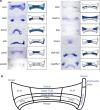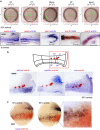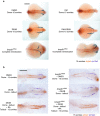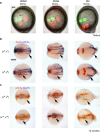BMP and retinoic acid regulate anterior-posterior patterning of the non-axial mesoderm across the dorsal-ventral axis
- PMID: 27406002
- PMCID: PMC4947171
- DOI: 10.1038/ncomms12197
BMP and retinoic acid regulate anterior-posterior patterning of the non-axial mesoderm across the dorsal-ventral axis
Abstract
Despite the fundamental importance of patterning along the dorsal-ventral (DV) and anterior-posterior (AP) axes during embryogenesis, uncertainty exists in the orientation of these axes for the mesoderm. Here we examine the origin and formation of the zebrafish kidney, a ventrolateral mesoderm derivative, and show that AP patterning of the non-axial mesoderm occurs across the classic gastrula stage DV axis while DV patterning aligns along the animal-vegetal pole. We find that BMP signalling acts early to establish broad anterior and posterior territories in the non-axial mesoderm while retinoic acid (RA) functions later, but also across the classic DV axis. Our data support a model in which RA on the dorsal side of the embryo induces anterior kidney fates while posterior kidney progenitors are protected ventrally by the RA-catabolizing enzyme Cyp26a1. This work clarifies our understanding of vertebrate axis orientation and establishes a new paradigm for how the kidney and other mesodermal derivatives arise during embryogenesis.
Figures









Similar articles
-
Anteroposterior and dorsoventral patterning are coordinated by an identical patterning clock.Development. 2013 May;140(9):1970-80. doi: 10.1242/dev.088104. Epub 2013 Mar 27. Development. 2013. PMID: 23536566 Free PMC article.
-
WNT8 and BMP2B co-regulate non-axial mesoderm patterning during zebrafish gastrulation.Dev Biol. 2005 Nov 15;287(2):237-48. doi: 10.1016/j.ydbio.2005.08.012. Epub 2005 Oct 10. Dev Biol. 2005. PMID: 16216234
-
Fgf signalling controls the dorsoventral patterning of the zebrafish embryo.Development. 2004 Jun;131(12):2853-64. doi: 10.1242/dev.01156. Epub 2004 May 19. Development. 2004. PMID: 15151985
-
The maternal coordinate system: Molecular-genetics of embryonic axis formation and patterning in the zebrafish.Curr Top Dev Biol. 2020;140:341-389. doi: 10.1016/bs.ctdb.2020.05.002. Epub 2020 Jun 16. Curr Top Dev Biol. 2020. PMID: 32591080 Review.
-
Maternal and zygotic control of zebrafish dorsoventral axial patterning.Annu Rev Genet. 2011;45:357-77. doi: 10.1146/annurev-genet-110410-132517. Epub 2011 Sep 13. Annu Rev Genet. 2011. PMID: 21942367 Review.
Cited by
-
Drivers of vessel progenitor fate define intermediate mesoderm dimensions by inhibiting kidney progenitor specification.Dev Biol. 2025 Jan;517:126-139. doi: 10.1016/j.ydbio.2024.09.008. Epub 2024 Sep 21. Dev Biol. 2025. PMID: 39307382
-
Specifying neural crest cells: From chromatin to morphogens and factors in between.Wiley Interdiscip Rev Dev Biol. 2018 Sep;7(5):e322. doi: 10.1002/wdev.322. Epub 2018 May 3. Wiley Interdiscip Rev Dev Biol. 2018. PMID: 29722151 Free PMC article. Review.
-
Sox10 is required for systemic initiation of bone mineralization.Development. 2025 Jan 15;152(2):dev204357. doi: 10.1242/dev.204357. Epub 2025 Jan 20. Development. 2025. PMID: 39791977 Free PMC article.
-
Ionising Radiation Induces Promoter DNA Hypomethylation and Perturbs Transcriptional Activity of Genes Involved in Morphogenesis during Gastrulation in Zebrafish.Int J Mol Sci. 2020 Jun 4;21(11):4014. doi: 10.3390/ijms21114014. Int J Mol Sci. 2020. PMID: 32512748 Free PMC article.
-
Redefining retinoic acid receptor expression in zebrafish embryos using Hybridization Chain Reaction.Differentiation. 2024 Nov-Dec;140:100822. doi: 10.1016/j.diff.2024.100822. Epub 2024 Nov 28. Differentiation. 2024. PMID: 39627912
References
-
- Lane M. C. & Sheets M. D. Rethinking axial patterning in amphibians. Dev. Dyn. 225, 434–447 (2002). - PubMed
-
- Kumano G. & Smith W. C. Revisions to the Xenopus gastrula fate map: implications for mesoderm induction and patterning. Dev. Dyn. 225, 409–421 (2002). - PubMed
-
- Warga R. M. & Nusslein-Volhard C. Origin and development of the zebrafish endoderm. Development 126, 827–838 (1999). - PubMed
-
- Fauny J. D., Thisse B. & Thisse C. The entire zebrafish blastula-gastrula margin acts as an organizer dependent on the ratio of Nodal to BMP activity. Development 136, 3811–3819 (2009). - PubMed
Publication types
MeSH terms
Substances
Grants and funding
LinkOut - more resources
Full Text Sources
Other Literature Sources
Molecular Biology Databases

